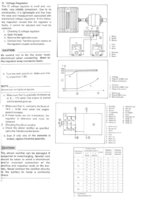http://www.xs400.com/forum/showpost.php?p=78311&postcount=59
Green wire goes to the Field coil.
Brown wire goes to the the Black wire on the field coil. Which also appears to ingition switch. So I am assuming that the power comes down the Brown wire after the switch is keyed on, and the other on/off/off switch is in the on position,
Lets think if you jumped br to green, The coil would be on at once. How much juice would use? Could it drain the battery over night, just cause you turned off the key, but left the on/off/off switch on?
Normal operation is in conjunction of the rectifier. If the rectifier has more power than is needed it wants to de-energize the field coil. If Power goes below 12 volts, Coil on, over 13.5 (give or take) coil off. Headlight high beam using 65 watts, a hit to the system, so coil on. Oh yea the rectifier also cleans the energy from a 3 stage generator to a DC compatible system. So if that what you wanna do. I suspect that the always on field coil will burn out a subsystem. perhaps rectifier, perhaps your battery will boil away.
Wow, keep us informed, perhaps nothing will happen immediately, for troubleshooting, I seem to remember doing a jumper for something. I am sure I did the energize the green wire, its just been 2 years, so I dont' remember as well as you younger kids might!

Good luck!
The black wire is just a ground. It connects up to the rest of the ground circuit. (on the VR)






 HEY! maybe I could try a ground jumper for the regulator!!! (im going to look into the variance my cheap meter is adding to the mix... Im not totally convinced my parts are garbage just yet)
HEY! maybe I could try a ground jumper for the regulator!!! (im going to look into the variance my cheap meter is adding to the mix... Im not totally convinced my parts are garbage just yet)